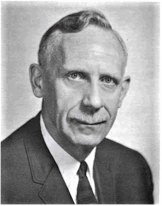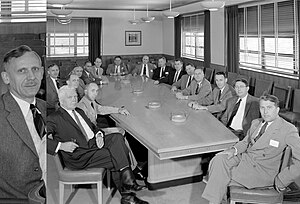World War II and new inventions
Change of direction
With the inexorable onset of World War II, Bode turned his sights on the military applications of his control systems research, a change of direction that would last in varying degree to the end of his career. He came to the service of his country by working on the Director Project at Bell Labs (funded by National Defense Research Committee (NDRC) Section D-2), developing automatic anti-aircraft control systems, whereby radar information was used to provide data about the location of the enemy aircraft, which was then fed back to the anti-aircraft artillery servomechanisms, enabling automatic, radar-augmented enemy aircraft ballistic tracking, in other words, automatic shooting down of enemy aircraft with the help of radar. The servomotors used were both electrically and hydraulically powered, the latter being used mainly for positioning the heavy anti-aircraft guns.
First wireless feedback loop and robot weapons
The radar signal was locked on target, and its data was wirelessly transmitted to a ground receiver that was connected to the artillery servomechanism feedback control system, causing the servo to accurately modify its angular position and maintain it for an optimal amount of time, long enough to fire at the calculated (predicted) coordinates of the target and thus successfully track the target.
The prediction of the coordinates was the function of director T-10, a form of electrical computer so named because it was used to direct the positioning of the gun with respect to the airborne target. It also calculated the target average velocity based on the location information provided by the radar and predicted the future target location based on its assumed flightpath equation, usually a linear function of time. This system functioned as an early version of the modern anti-ballistic missile defence model. Statistical analysis was also employed to aid in the computation of the exact position of the enemy aircraft and to smooth the data acquired from the target due to signal fluctuations and noise effects.
"Shotgun marriage"
Bode therefore realized the first wireless data feedback loop in the history of automatic control systems by combining wireless data communications, electrical computers, statistics principles and feedback control systems theory. He showed his dry sense of humour by calling this multidisciplinary linkage a shotgun marriage, referring to the antiaircraft artillery origins of his historic invention, saying: "This, I said, was a sort of shotgun marriage forced upon us by the pressures of military problems in World War II." He also described it further as "a sort of 'shotgun marriage' between two incompatible personalities" and characterised the product of that linkage as a "son of shotgun marriage".
The product of this "marriage", i.e. the automated artillery gun, can also be considered as a robot weapon. Its function required to process data that was wirelessly transmitted to its sensors and make a decision based on the data received using its onboard computer about its output defined as its angular position and the timing of its firing mechanism. In this model we can see all the elements of later concepts such as data processing, automation, artificial intelligence, cybernetics, robotics etc.
Working on director studies
Bode, in addition, applied his extensive skills with feedback amplifiers to design the target data smoothing and position predictor networks of an improved model of director T-10, called the director T-15. The work on director T-15 was undertaken under a new project at Bell Labs called Fundamental Director Studies in cooperation with the NDRC under the directorship of Walter McNair.
NDRC, the funding agency of this project, was operating under the aegis of the Office of Scientific Research and Development (OSRD).
His NDRC-funded research at Bell Labs under the section D-2 (Control Systems section) contract eventually led to other important developments in related fields and laid the cornerstone for many present-day inventions. In the field of control theory, for example, it aided in the further development of servomechanism design and control, a crucial component of modern robotics. The development of wireless data communications theory by Bode led to later inventions such as mobile phones and wireless networking.
The reason for the new project was that director T-10 encountered difficulties in calculating the target velocity by differentiating the target position. Due to discontinuities, variations and noise in the radar signal, the position derivatives sometimes fluctuated wildly, and this caused erratic motion in the servomechanisms of the gun because their control signal was based on the value of the derivatives. This could be mitigated by smoothing or averaging out the data, but this caused delays in the feedback loop that enabled the target to escape. As well, the algorithms of director T-10 required a number of transformations from Cartesian (rectangular) to polar coordinates and back to Cartesian, a process that introduced additional tracking errors.
Bode designed the velocity computing networks of director T-15 by applying a finite difference method instead of differentiation. Under this scheme the target positional coordinates were stored in a mechanical memory, usually a potentiometer or a cam. The velocity was then calculated by taking the difference between the coordinates of the current position and the coordinates of the previous reading that were stored in memory and dividing by the difference of their respective times. This method was more robust than the differentiation method, and it also smoothed out signal disturbances, since the finite time-step size was less sensitive to random signal impulses (spikes). It also introduced for the first time an algorithm better suited to modern digital signal processing theory rather than to the classical calculus-based analog signal processing approach that was followed then. Not coincidentally it is an integral part of modern digital control theory and digital signal processing and is known as the backward difference algorithm. In addition, the director T-15 operated only in rectangular coordinates, thus eliminating coordinate-transformation-based errors. These design innovations paid performance dividends, and the director T-15 was twice as accurate as its predecessor and converged on a target twice as fast.
The fire control algorithm implementation of his artillery design research and his extensive work with feedback amplifiers advanced the state of the art in computational methods and led to the eventual development of the electronic analog computer, the operational amplifier based alternative of today's digital computers.
Inventions such as these, despite their military research origins, have had a profound and lasting impact in the civilian domain.
Military uses
Anzio and Normandy
The automated anti-aircraft guns that Bode helped develop were successfully used in numerous instances during the war. In February 1944, an automated fire control system based on the earlier version of the director T-15, called the director T-10 by Bell Labs or director M-9 by the military, saw action for the first time in Anzio, Italy, where it helped down over one hundred enemy aircraft. On D-day 39 units were deployed in Normandy to protect the allied invading force against Hitler's Luftwaffe.
Use against the V-1 flying bomb
Perhaps the menace best suited for the design specifications of such an automated artillery system appeared in June 1944. It was another robot. The German aeronautical engineers aided by Wernher von Braun produced a robot of their own: the V-1 flying bomb, an automatically guided bomb and widely considered a precursor of the cruise missile. Its flight specifications almost perfectly suited the target design criteria of director T-10, that of an aircraft flying straight and level at constant velocity, in other words a target nicely fitting the computing capabilities of a linear predictor model such as the director T-10. Although the Germans did have a trick up their engineering sleeve by making the bomb fly fast and low to evade radar, a technique widely adopted even today. During the London Blitz one hundred 90 mm automated gun units assisted by director T-10 were set up in a perimeter south of London, at the special request of Winston Churchill. The AA units included the SCR-584 radar unit produced by the Radiation Lab at MIT and the proximity fuse mechanism, developed by Merle Tuve and his special Division T at NDRC, that detonated near the target using a microwave controlled fuse called the VT, or variable time fuse, enabling a larger detonation reach envelope and increasing the chances of a successful outcome. Between June 18 and July 17, 1944, 343 V-1 bombs were shot down, or 10% of the total V-1 number sent by the Germans and about 20% of the total V-1 bombs shot down. From July 17 to August 31 the automated gun kills rose to 1286 V-1 rockets, or 34% of the total V-1 number dispatched from Germany and 50% of the V-1 actually shot down over London. From these statistics it can be seen that the automated systems that Bode helped design had a considerable impact on crucial battles of World War II. It can also be seen that London at the time of the Blitz became, among other things, the original robot battlefield.
Synergy with Shannon
In 1945, as the war was winding down, the NDRC was issuing a summary of technical reports as the prelude to its eventual closing down. Inside the volume on fire control a special essay titled Data Smoothing and Prediction in Fire-Control Systems, coauthored by Ralph Beebe Blackman, Hendrik Bode, and Claude Shannon, formally introduced the problem of fire control as a special case of transmission, manipulation and utilization of intelligence, in other words, it modeled the problem in terms of data and signal processing and thus heralded the coming of the information age. Shannon, considered to be the father of information theory, was greatly influenced by this work. It is clear that the technological convergence
of the information age was preceded by the synergy between these scientific minds and their collaborators.
Further wartime achievements
In 1944, Bode was placed in charge of the Mathematical Research Group at Bell Laboratories.
His work on electronic communications, especially on filter and equalizer design, continued during this time. In 1945 it culminated in the publication of his book under the title of Network Analysis and Feedback Amplifier Design, which is considered a classic in the field of electronic telecommunications and was extensively used as a textbook for many graduate programs at various universities, as well as for internal training courses at Bell Labs.
He was also the prolific author of many research papers that were published in prestigious scientific and technical journals.
In 1948, President Harry S. Truman awarded him the President's Certificate of Merit, in recognition of his remarkable scientific contributions to the war effort and to the United States of America.

